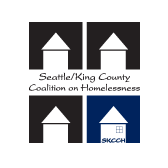Several Solid Ground staff members participated in the annual One Night Count of homeless people in King County described in this post. Guest contributor Ray Lumpp is a writer for AllTreatment.com, a website devoted to helping individuals and families facing addiction and mental health issues in Washington State.
In the early hours of January 25, 2013, over 900 volunteers for the Seattle/King County Coalition on Homelessness (SKCCH) spread out across the city and county, searching for men, women and children sleeping outdoors without shelter. Since 1980, SKCCH and Operation Nightwatch have organized the One Night Count. Today, it remains the largest community-organized count in the United States.
In 2013, at least 2,736 men, women and children were found sleeping in cars, riding late-night buses, or curled up in blankets under bridges or in doorways during the three-hour street count – a 5% increase from last year’s total. This number is always assumed to be an underestimate: It is impossible to count everywhere, and many people take great care not to be visible.

Estimated number of people found on the streets or sleeping in cars in Seattle/King Co., ’06-’13 (chart by Ray Lumpp, ’13)
This year, one group of volunteers, including Councilmember Sally Clark, discovered the dead body of a 60-year-old woman near the terminus of I-90 – a sobering reminder of what’s at stake for homeless individuals.
While the One Night Count provides a basic census for tracing the problem of homelessness in King County, another volunteer-based group assembled by the City of Seattle sought to dig deeper. One evening in April 2009, the Homeless Needs Assessment group surveyed 297 homeless people and recorded demographic information for an additional 89 individuals, providing a crucial glimpse of life on the street.
Think of homelessness as a local problem: Most homeless people in Seattle have been living without shelter for over a year and 23% have been living without shelter for over six years. Nearly two thirds reported living in Seattle, and 19% elsewhere in Washington, when they became homeless. Although 91% of people living on the streets would like to find housing, people often wait two years or more for affordable housing options to open up.

Racial disproportionality of Seattle’s homeless population compared to the general population (chart by Ray Lumpp, ’13)
Compared to Seattle’s general population, there was a disproportionate number of African Americans (29%), Hispanic or Latinos (13%), and Native Americans (6%), which is similar to the disproportionate number of people with unmet addiction treatment needs. Limited access to information about homeless services is a continuing problem: 67% learned of available services through word of mouth or on the street, while only 10% reported learning of services from an agency or program. Coordinating an effective outreach effort among food banks, drop-in centers, and shelters may help increase access to services.
Food and hygiene programs are the most common services used by homeless people in Seattle. Seventy percent reported using a food bank in the last six months and 48% used meal programs. About half reported using hygiene centers, but only 37% reported staying in a shelter during the last six months. Most of these programs are run and supported by local volunteers, community groups, and ex-homeless people looking to give back and stay clean.
Another telling statistic is that 60% reported health conditions requiring professional care. Though the conditions may range from diabetes to alcoholism, many homeless people use emergency departments for their health needs instead of primary care physicians – wasting time, energy, and taxpayer dollars. In answer to this, DESC (Downtown Emergency Service Center) focuses on the needs of homeless chronic alcoholics who are the heaviest users of publicly-funded crisis services. Exploring other alternative housing models may also help shelter more people in the future.
Interestingly, people who received medical care accessed services at a higher rate. Respondents with recent hospitalization or mental health treatment made greater use of meal programs, hygiene centers, shelter, and other services than those not receiving medical care.
While homelessness continues to be a growing national problem, there are many ways you can create a positive change in your community. Volunteer with a shelter or housing program. (Solid Ground’s Broadview Shelter and Brettler Family Place at Sand Point Housing both have volunteer opportunities.) Donate clean clothes (especially shoes), books, toys, diapers, shampoo, toothpaste, toothbrushes, blankets, old cell phones, or even gift cards to Starbucks or a grocery store. (Broadview Shelter and Sand Point Housing both also have in-kind donation wish lists.)
You can also give money or gift cards to people experiencing homelessness on the street. Do not ignore them. If you have nothing else to give, simply smile and look into his or her eyes and let them know, even just by noticing them, that you recognize their humanity and that you care.
Filed under: Housing | Tagged: affordable housing, Brettler Family Place, Broadview shelter, homeless, homeless in Seattle, Housing, one night count, Seattle/King County Coalition on Homelessness |


[…] a chart found here, we can see how the situation has changed since […]